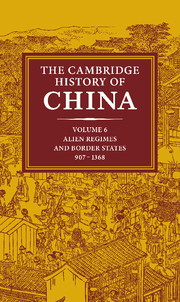Book contents
- Frontmatter
- Introduction
- 1 The Liao
- 2 The Hsi Hsia
- 3 The Chin dynasty
- 4 The rise of the Mongolian empire and Mongolian rule in north China
- 5 The reign of Khubilai khan
- 6 Mid-Yüan politics
- 7 Shun-ti and the end of Yüan rule in China
- 8 The Yüan government and society
- 9 Chinese society under Mongol rule, 1215–1368
- Bibliographical essays
- Bibliography
- Glossary-Index
- MAP 7. The Liao empire, ca. 1045
- MAP 12. The Hsi Hsia state, IIII
- Map 17. The Chin empire
- MAP 32. The Yüan empire">
- References
2 - The Hsi Hsia
Published online by Cambridge University Press: 28 March 2008
- Frontmatter
- Introduction
- 1 The Liao
- 2 The Hsi Hsia
- 3 The Chin dynasty
- 4 The rise of the Mongolian empire and Mongolian rule in north China
- 5 The reign of Khubilai khan
- 6 Mid-Yüan politics
- 7 Shun-ti and the end of Yüan rule in China
- 8 The Yüan government and society
- 9 Chinese society under Mongol rule, 1215–1368
- Bibliographical essays
- Bibliography
- Glossary-Index
- MAP 7. The Liao empire, ca. 1045
- MAP 12. The Hsi Hsia state, IIII
- Map 17. The Chin empire
- MAP 32. The Yüan empire">
- References
Summary
INTRODUCTION
At its height in the middle of the twelfth century the Hsia state (ca. 982–1227) embraced the Ordos and the Kansu corridor. In the northeast it abutted the Chin empire along the Yellow River; westward it extended beyond Tun-huang to Yü-men, north to Edzina (O-chi-na; Khara-Khoto) on the southern rim of the Gobi, and south to Hsi-ning, skirting Lake Kokonor and the city of Lan-chou. From his capital city of Chung-hsing on the west bank of the Yellow River in the foothills of the Alashan (Ho-lan Mountains), the Tangut emperor ruled over a multiethnic, economically diversified population numbering perhaps three million. His subjects included Chinese, Tibetans, Uighurs, Khitans, and various other Ch'iang and Turkic groups in addition to the Tangut core.
It is difficult to determine how far the ethnic boundaries between these groups remained distinct or blurred. No law prohibited intermarriage. The Tangut, Chinese, and Tibetan languages enjoyed official recognition and widespread usage. The administrative apparatus bore the outer trappings of its Chinese models, though its inner workings still remain mostly unknown. Imperial revenues were derived from taxes, largely in kind, on the products of animal husbandry and irrigated agriculture, as well as on internal and foreign trade.
As the preeminent state religion, Buddhism was lavishly patronized by the imperial family and court. The synthetic Tangut brand of northern Buddhism blended Tibetan Tantric and Chinese Mahāyāna scriptural traditions in a Sino-Nepalese artistic setting, often referred to as the Khara-Khoto style. This religion provided the outstanding inspiration of Tangut culture, judging by its literary and material remains.
Keywords
- Type
- Chapter
- Information
- The Cambridge History of China , pp. 154 - 214Publisher: Cambridge University PressPrint publication year: 1994
References
- 5
- Cited by



